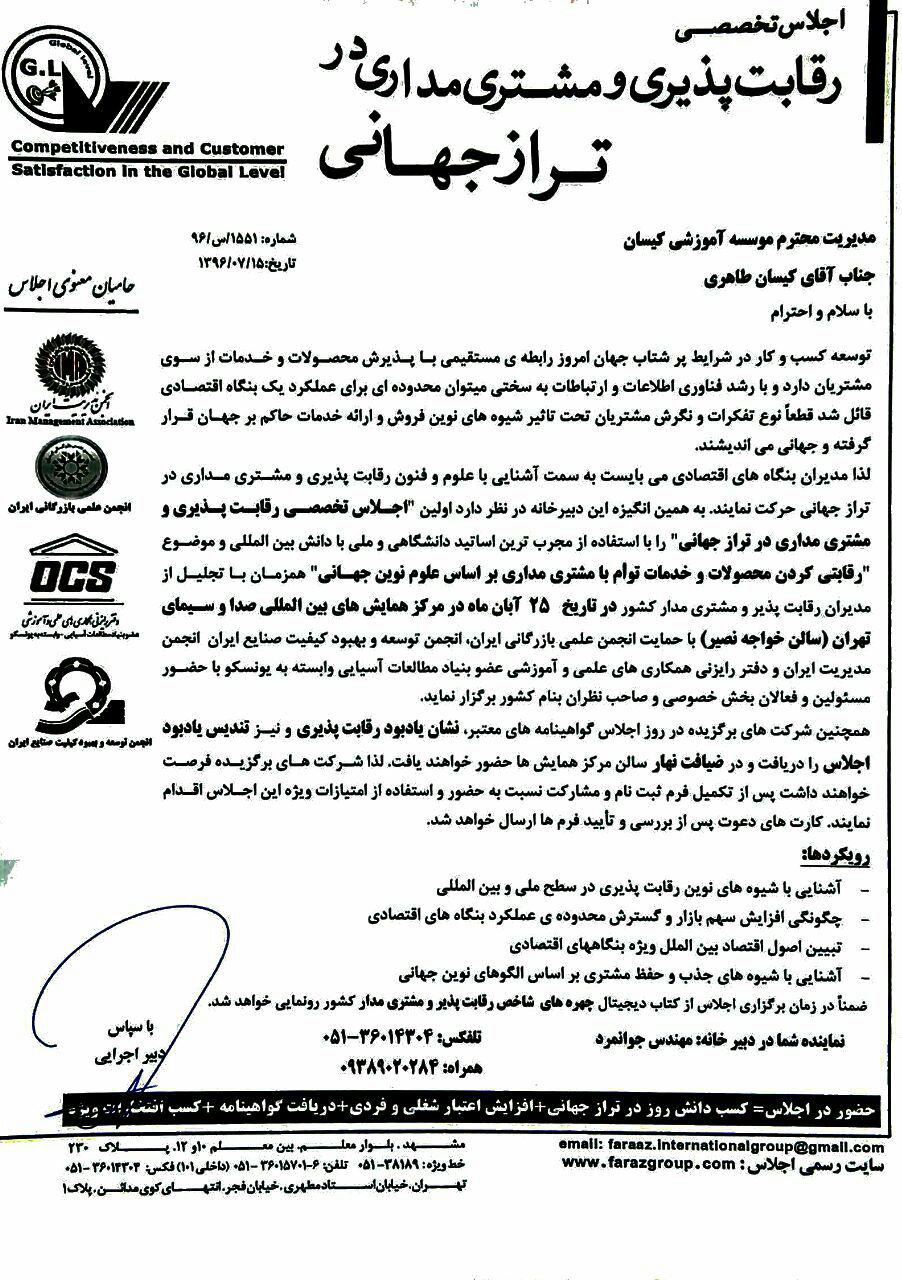دعوت به اجلاس سران رقابت پذیری مدیران برتر

موسسه آموزشی کیسان – دعوت به اجلاس سران رقابت پذیری مدیران برتر
موسسه آموزشی کیسان برند برتر سال 96و97 برگزار کننده دروس تقویتی و کنکوربا توجه به موفقیت های گوناگون آموزشی و علمی در زمینه های مختلف و کسب امتیاز عالی مدیریت آموزشی به اجلاس سران رقابت پذیری در تراز جهانی دعوت شده است.
موسسه آموزشی کیسان این قول را میدهد با تلاش مضاعف و پشتکار چند برابر بهترین نوع خدمت و آموزش را به دانش آموزان،دانش دوستان، داوطلبین کنکور و… ارائه دهد.
به امید کسب موفقیت های بیشتر با همکاری و همراهی اساتید و دانش آموزان عزیز.
در موسسه آموزشی کیسان از تمامی متد های روز دنیا جهت بهبود کیفیت بهره برده میشود.
در حال حاضر با داشتن بیش از ۷۰۰۰ دانش آموز از جمله موسسات فعال در سطح کشور میباشد.
همچنین موسسه آموزشی کیسان،تنها موسسه آموزشی در کشور میباشد که در دو سال متوالی،
(۹۶ و ۹۷) موفق به کسب عنوان برند برتر آموزشی سال شده است.
امیررضا طاهری،مدیر عامل موسسه آموزشی کیسان نیز، عنوان کارآفرین نمونه جوان کشور را در سال
۹۷ از آن خود کرده است.
همچنین امیررضا طاهری موسس و مدیر عامل موسسه اموزشی وفرهنگی کیسان سال 99 به عنوان
جوان ترین مدیر عالی سال انتخاب شد
از حامیان این موسسه آموزشی، میتوان به سازمان شهرداری منطقه ۶، سازمان توسعه
مدیریت،دانشگاه علامه طباطبایی، دانشگاه رایانه ای تهران، سازمان گسترش و نوسازی صنایع، بنیاد
نخبگان،وزارت صنعت، انجمن روابط عمومی،انجمن متخصصین ،انجمن سواد رسانه و کانون فرهنگیان
اشاره کرد.
جهت کسب اطلاعات بیشتر و یا ثبت نام دوره های آموزشی با شماره های موسسه تماس حاصل بفرمایید:
شعبه 1:یوسف اباد- خیابان چهلستون
شعبه 2:میرداماد، میدان مادر، خیابان شاه نظری، کوچه دوم پلاک ۱۵ واحد ۱۰
شعبه 3:تهران، لواسان، بلوار امام خمینی، نبش گلهای سوم
شعبه 4:یزد، بلوار جهاد، خیابان پاسداران
شعبه 5:آمل، روبروی بیمارستان ۱۷ شهریور
شعبه 6:مراغه، خیابان خواجه نصیر روبروی فرمانداری
شعبه 7:شیراز، خیابان بیست متری سینما سعدی، روبروی کوچه هفت تیر ششم
شعبه8:تهران جردن مدرسه حضرت زهرا
شعبه 9:کویت خیابان سلوی قطعه 1 شارع 1 مدخل شارع 4 ویلا 18روبروی مسجد معرفی
02122251323
۰۹۰۲۹۰۸۲۸۰۷
هم اکنون آماده ارائه بهترین کیفیت آموزشی به شما دانش آموزان و دانشجویان عزیز و گرانقدر میباشیم.
موسس و مدیر عامل: امیررضا طاهری
موسسه آموزشی کیسان
مطالب زیر را حتما مطالعه کنید
700 دیدگاه
به گفتگوی ما بپیوندید و دیدگاه خود را با ما در میان بگذارید.







Opening a t-shirt business is an rewarding endeavor for business
owners looking to enter the apparel industry. With an effective approach
and commitment, your t-shirt shop can thrive and become a
flourishing business. Here are some important steps to consider when opening a t-shirt shop.
### Initial Planning
Drafting a thorough business plan is essential for
the success of of your t-shirt shop. This blueprint should cover your audience, advertising plans,
financial plan, and aims. Knowing your target market can help tailor your products
and marketing efforts to meet their needs.
### Creating the T-Shirts
Designing of your t-shirts is a critical element in drawing buyers.
Work with talented artists to craft eye-catching and stylish patterns that resonate with
your target market. Think about utilizing diverse processes,
including screen printing, direct-to-garment printing, and heat transfer, depending on your preferences and the desired
quality of the apparel.
### Sourcing Materials
Selecting reliable suppliers for your materials is
crucial to make sure of reliable products. Look for vendors that offer high-quality plain t-shirts in various colors.
Establishing a good partnership with your vendors will help
maintain timely shipments and affordable prices.
### Creating an Online Store
In today’s internet age, having an e-commerce site is crucial for accessing a more extensive market.
Develop an user-friendly and functional online store to showcase your products.
Use clear images and detailed information to offer visitors a better understanding
of what they are buying. Look into including options like safe transactions methods, customer reviews, and social media integration to improve customer interaction.
### Advertising and Marketing
Strategic advertising is crucial to bringing in visitors
to your t-shirt shop. Utilize multiple marketing
channels, including social media, newsletters, influencer marketing, and SEO.
Social media platforms provide you to reach a large audience and
showcase your products.
Sending newsletters is another method to keep your audience and inform them about new products, special offers, and
future events. Partnering with influencers can also help in connecting with new customers.
### Customer Service
Providing exceptional support is crucial for creating a faithful clientele.
Make sure that your clients have a positive experience from beginning to end.
Respond to concerns and issues quickly and courteously.
Offering convenient refunds and transparent policies
can aid in establishing confidence with your audience.
### Reviewing Performance
Frequently reviewing your sales can help detect aspects for growth and adjust your {strategies|approaches
Music sheets and scores act as the blueprint for musicians.
Understanding Music Sheets and Scores
Music notations and scores comprise the written notation of musical compositions.
Elements of Music Sheets and Scores
1. **Stave:** A framework of lines and spaces used to notate musical
pitches.
2. **Signs:** Signs that designate the pitch range for notes on the staff.
3. **Notes:** Symbols denoting the pitch and duration of a musical sound.
4. **Breaks:** Notations that represent periods of
silence.
5. **Rhythm:** Indicates the metric structure of a piece.
6. **Scale:** Defines the tonality of the piece.
7. **Volume:** Notations indicating the intensity of the music.
8. **Expression:** Indicators of the expression or phrasing of notes.
9. **Pace:** The speed at which the piece should be performed.
10. **Ornaments:** Notes or symbols that add expressiveness to the music.
Reading Music Sheets and Scores
Understanding music sheets and scores requires awareness of the various components and notations
used.
Benefits of Learning to Read Music Sheets and Scores
1. **Deeper Comprehension:** Reading music sheets enhances one’s understanding of music theory and composition.
2. **Broader Skill Set:** Greater flexibility in playing different genres and styles is achieved by reading music.
3. **Better Communication:** Improved interaction with
other musicians is possible when reading music.
4. **Documentation:** Documenting music through scores ensures its longevity.
5. **Personal Fulfillment:** The achievement of reading music brings
a sense of personal satisfaction.
Tips for Beginners
1. **Keep it Basic:** Keep it simple in the beginning to build a
strong foundation.
2. **Consistent Practice:** Consistent practice
helps reinforce learning.
3. **Use Resources:** Take advantage of available resources to aid in learning.
4. **Find a Group:** Find a group of like-minded individuals to share your learning journey.
5. **Stay Persistent:** Stay persistent and don’t get discouraged by challenges.
Advanced Techniques
1. **Instant Interpretation:** The ability to read and play a piece of music on the spot
without prior preparation.
2. **Modulating:** The process of changing the key of a piece of music.
3. **Harmonization:** Building chords to accompany a musical piece.
4. **Spontaneous Composition:** Spontaneous composition of music on the spot.
5. **Expressive Playing:** Adding personal expression to the performance
of written music.
Famous Composers and Their Scores
1. **L. Beethoven:** Famous for his impactful and intricate musical works.
2. **Mozart:** Renowned for his musical brilliance and creativity.
3. **Johann Sebastian Bach:** Famous for his intricate
and harmonically rich compositions.
4. **Pyotr Ilyich Tchaikovsky:** Famous
for his richly orchestrated and emotive music.
5. **Claude Debussy:** Known for his unique and expressive musical style.
Digital vs. Traditional Music Scores
**Advantages of Digital Scores:**
– Convenience: Convenient for on-the-go use.
– Editing: Simple to make changes and adjustments.
– Capacity: Easy to store and organize.
**Benefits of Paper Music:**
– Physical Interaction: Engaging tactile experience.
– Resilience: Stands the test of time.
– Visual Beauty: Aesthetic and artistic value.
The Role of Technology in Music Scores
Technology has revolutionized the way we engage with
music scores.
**Digital Sheet Music Apps:** Apps like MuseScore, Noteflight, and Sibelius offer powerful
tools for creating, editing, and sharing music scores.
**Online Libraries:** Online libraries provide access to a wide range of music scores.
**Interactive Learning Tools:** Technology-based tools provide interactive music learning opportunities.
Conclusion
Music sheets and scores are integral to the art of musicianship.
Whether you just began or have experience,
learning how to read and interpret music sheets and scores is advantageous.
Embrace the path of understanding music sheets and scores, and unlock the endless possibilities they offer.
Music sheets represent a captivating history that extends across centuries.
Early Beginnings
The initial forms of music notation trace back to prehistoric times.
Ancient Mesopotamians designed basic music notation systems to document their melodies.
The Greek Contribution
Ancient Greece made significant contributions to music notation.
Medieval Innovations
The medieval period experienced considerable developments in music notation.
The Renaissance Era
The Renaissance brought a resurgence of art, including music notation.
Baroque and Classical Periods
During the Classical periods, music notation developed further, becoming
increasingly detailed.
The Romantic Era
The Romantic era brought about new expressive styles in music notation.
The Modern Age
In the modern era, music notation underwent significant changes, adopting electronic systems.
The Digital Revolution
The introduction of computer-based scores transformed the field of music
notation.
Key Milestones in Music Notation History
1. **Primitive Symbols:** Ancient Greek symbols that represented musical
concepts.
2. **Staff Lines:** Guido d’Arezzo’s revolutionary contributions to music notation.
3. **Classical Evolution:** Evolution of
musical scores in the Classical era.
4. **Romantic Period:** 19th-century innovations in music notation techniques.
5. **Contemporary Techniques:** Adoption of digital notation tools in contemporary music.
The Role of Music Sheets in Education
Music sheets play a crucial function in music pedagogy.
Notable Composers and Their Contributions
1. **Johann Sebastian Bach:** Known for his complex and detailed musical scores.
2. **L. Beethoven:** Pioneered expressive notations and dynamic markings.
3. **Wolfgang Amadeus Mozart:** Perfected the Classical approach
to elegant and clear notation.
4. **F. Chopin:** Expanded the use of expressive notations
for piano music.
5. **I. Stravinsky:** Pioneered 20th-century notational
innovations.
Evolution of Music Sheets in the Digital Age
The modern era has dramatically altered the approach we interact with music
sheets.
Future of Music Sheets
The future of music sheets foresees innovative innovations.
As technology proceeds to advance, likewise will the methods composers use to compose and share music sheets.
Conclusion
The history of music sheets holds depth, reflecting the progress of music itself.
From ancient symbols to electronic sheets, music sheets have been a crucial tool for documenting and distributing musical ideas.
As we look ahead, the story of music sheets shall endure, evolving with
future advancements.}
The history of music sheets is a vivid tapestry that extends across
millennia.
Early Beginnings
The earliest versions of music notation go back to ancient civilizations.
Ancient Mesopotamians developed simple music notation systems to document their melodies.
The Greek Contribution
The Greeks made notable contributions to music notation.
Medieval Innovations
The Dark Ages saw substantial developments in music
notation.
The Renaissance Era
Renaissance period brought a rebirth of art, including music notation.
Baroque and Classical Periods
During the Baroque periods, music notation evolved further, growing more sophisticated.
The Romantic Era
The Romantic era brought about novel dynamic techniques in music notation.
The Modern Age
In the 20th century, music notation experienced major changes, integrating digital
tools.
The Digital Revolution
The introduction of digital music transformed the field of music notation.
Key Milestones in Music Notation History
1. **Primitive Symbols:** Ancient Greek symbols that
represented musical concepts.
2. **Guido d’Arezzo:** Guido d’Arezzo’s revolutionary contributions to music notation.
3. **Baroque Notation:** Development of complex notational systems in the Baroque period.
4. **Romantic Period:** Incorporation of expressive dynamics and articulations
in the Romantic era.
5. **Modern Notation:** Revolutionary changes in music notation practices
in the modern age.
The Role of Music Sheets in Education
Music sheets serve a important function in learning music.
Notable Composers and Their Contributions
1. **Bach:** Renowned for his elaborate and accurate
notation techniques.
2. **L. Beethoven:** Pioneered expressive notations and dynamic markings.
3. **Mozart:** Mastered the Classical style of clear and
elegant notation.
4. **Frédéric Chopin:** Expanded the use of expressive notations for
piano music.
5. **I. Stravinsky:** Known for his groundbreaking 20th-century notational techniques.
Evolution of Music Sheets in the Digital Age
The contemporary period has dramatically altered the approach we interact with
music sheets.
Future of Music Sheets
The coming age of music sheets promises intriguing developments.
With the advancement of technology, the techniques artists
use to create and publish music sheets will in parallel
advance.
Conclusion
The history of music sheets holds depth, mirroring the advancement of music itself.
From primitive notations to modern notations, music sheets have functioned as a vital tool for preserving and distributing
compositions.
As we progress, the story of music sheets will persist, evolving with each new era.
}
Understanding music sheets is essential for any beginning musician. | Understanding how to
read music sheets is vital for every beginning musician. | Understanding the art of reading music
sheets is essential for every beginning musicians.}
What Are Music Sheets?
Music sheets serve as written forms of musical notes,
showing the note and rhythm of a music composition.
Getting Started with Music Sheets
Grasping how to read music sheets starts with becoming familiar with the fundamental elements of music notation.
Understanding Musical Notation
Musical notation involves a few important elements, including notes,
staff, rhythms, and clefs.
The foundation of musical notation is truly the staff.
In that music notation, this actually consists of five distinct horizontal lines as well as,
four different spaces.
2. **Clefs
This indicate which musical note is meant to the five lines and also
spaces. | Clefs indicate which musical note the actual note for the lines and the different spaces.
| Clefs is meant to these lines as well as these different
spaces.}
{There {are actually|actually are|is} {two|two separate|two distinct} {primary|different|distinct} {clefs|clef|music notes} {used in|used in various|used in the} {music|musical} {notation|notes|notations}.
| There {are actually|actually are|is} {two|two separate|two distinct} {primary|different|distinct} {clefs|musical notes|clef}
{used in|used in various|used in the} {notations|music|musical} {of|music} {these notes|these notes}.
Music sheets and scores provide the crucial assistance for artists to perform pieces correctly.
Understanding Music Sheets and Scores
Music manuscripts and scores comprise the written notation of musical works.
Elements of Music Sheets and Scores
1. **Staff:** The lines and spaces used to notate the pitch
and duration of notes.
2. **Symbols:** Signs that designate the pitch range for notes on the staff.
3. **Tones:** The symbols used to indicate the pitch and duration of sounds in music.
4. **Rests:** Symbols used to indicate moments of silence in a piece.
5. **Meter:** Denotes the rhythmic structure of the composition.
6. **Key Signature:** Indicates the key of the music by specifying which notes are sharp or flat.
7. **Intensity:** Indications of the volume of the music.
8. **Articulation:** Instructions on how to perform each note or phrase.
9. **Pace:** Shows how fast or slow the music should
be played.
10. **Ornaments:** Notes or symbols that add
expressiveness to the music.
Reading Music Sheets and Scores
Understanding music sheets and scores demands awareness of the
various elements and signs used.
Benefits of Learning to Read Music Sheets and Scores
1. **Improved Knowledge:** Reading music sheets enhances
one’s understanding of music theory and composition.
2. **Broader Skill Set:** Musicians who read music can play a wider
variety of pieces.
3. **Better Communication:** Improved interaction with
other musicians is possible when reading music.
4. **Preservation of Music:** Written music preserves compositions for
future generations.
5. **Satisfaction:** Learning to read music can be a deeply fulfilling and rewarding experience.
Tips for Beginners
1. **Start Simple:** Begin with simple pieces and gradually move to more complex ones.
2. **Frequent Practice:** Frequent practice is key
to mastering music reading.
3. **Take Advantage of Tools:** Take advantage of available resources
to aid in learning.
4. **Find a Group:** Seek support from others who are also learning to read music.
5. **Keep Trying:** Keep trying and don’t give up,
even when it gets tough.
Advanced Techniques
1. **On-the-Spot Playing:** The ability to read and play a
piece of music on the spot without prior preparation.
2. **Modulating:** Modulating music to a different key.
3. **Creating Harmonies:** Building chords
to accompany a musical piece.
4. **Ad-Libbing:** Ad-libbing music as it is played.
5. **Personal Expression:** Adding personal expression to the performance of written music.
Famous Composers and Their Scores
1. **Ludwig van Beethoven:** Famous for his impactful and intricate musical
works.
2. **Mozart:** Renowned for his musical brilliance and creativity.
3. **Bach:** Known for his masterful use of counterpoint and harmony.
4. **P. I. Tchaikovsky:** Famous for his richly orchestrated and emotive music.
5. **Debussy:** Renowned for his innovative use of harmony
and texture.
Digital vs. Traditional Music Scores
**Benefits of Digital Music:**
– Accessibility: Easily accessible on various devices.
– Alteration: Simple to make changes and adjustments.
– Capacity: Takes up less physical space.
**Pros of Printed Sheets:**
– Tactile Experience: Provides a tangible, hands-on experience.
– Longevity: Stands the test of time.
– Aesthetic Appeal: Visually appealing.
The Role of Technology in Music Scores
Technology has changed the way we interact with music
scores.
**Digital Sheet Music Apps:** Apps like MuseScore, Noteflight, and Sibelius offer
powerful tools for creating, editing, and sharing music scores.
**Online Libraries:** Online libraries provide access to a wide range of music scores.
**Interactive Learning Tools:** Technology-based tools provide interactive
music learning opportunities.
Conclusion
Music sheets and scores are integral to the art of musical
creation.
Whether you are a novice or have experience,
knowing how to read and interpret music sheets and scores is beneficial.
Embrace the journey of learning music sheets and scores, and reveal the potential they offer.
The history of music sheets is a deep tapestry that
extends across centuries.
Early Beginnings
The earliest forms of music notation trace back to prehistoric times.
Ancient Greeks designed basic music notation techniques to
preserve their musical practices.
The Greek Contribution
Greek society made significant contributions to music notation.
Medieval Innovations
The Middle Ages experienced considerable progress in music notation.
The Renaissance Era
The Renaissance brought a rebirth of culture, including
music notation.
Baroque and Classical Periods
During the Baroque periods, music notation advanced further, becoming more sophisticated.
The Romantic Era
The Romantic age ushered in novel emotional styles in music notation.
The Modern Age
In the contemporary period, music notation experienced major changes, integrating digital tools.
The Digital Revolution
The introduction of digital music transformed the landscape of music notation.
Key Milestones in Music Notation History
1. **Ancient Notations:** Ancient Greek symbols that represented musical
concepts.
2. **Guido d’Arezzo:** Development of staff lines
and notation methods in medieval Europe.
3. **Baroque Notation:** Evolution of musical
scores in the Classical era.
4. **Expressive Notation:** Increased complexity and detail
in Romantic music notation.
5. **Modern Notation:** Introduction of graphic scores and experimental notation in the 20th century.
The Role of Music Sheets in Education
Music sheets serve a important part in learning
music.
Notable Composers and Their Contributions
1. **J.S. Bach:** Known for his complex and detailed musical scores.
2. **L. Beethoven:** Advanced the use of expressive dynamics
in notation.
3. **Wolfgang Amadeus Mozart:** Perfected the Classical
approach to elegant and clear notation.
4. **F. Chopin:** Known for his detailed and expressive piano
music notations.
5. **Stravinsky:** Pioneered 20th-century notational innovations.
Evolution of Music Sheets in the Digital Age
The contemporary period has profoundly transformed the method we create music sheets.
Future of Music Sheets
The coming age of music sheets promises exciting developments.
As technology progresses, the tools musicians use to compose
and publish music sheets will so too evolve.
Conclusion
The journey of music sheets is rich, showcasing the advancement of music itself.
From ancient symbols to digital scores, music sheets have been a vital medium for documenting and
sharing compositions.
As we move forward, the legacy of music sheets will persist, changing with technological progress.
}
Music sheets contain a intriguing history that spans across millennia.
Early Beginnings
The earliest forms of music notation go back to ancient
civilizations.
Ancient Greeks developed simple music notation systems to
record their melodies.
The Greek Contribution
Ancient Greece made notable contributions to music notation.
Medieval Innovations
The Dark Ages witnessed substantial progress in music notation.
The Renaissance Era
The Renaissance brought a resurgence of culture, including music notation.
Baroque and Classical Periods
During the Baroque and Classical periods, music notation evolved further, becoming increasingly complex.
The Romantic Era
The Romantic era ushered in new expressive methods in music notation.
The Modern Age
In the modern era, music notation saw significant changes, integrating digital tools.
The Digital Revolution
The introduction of computer-based scores transformed the
landscape of music notation.
Key Milestones in Music Notation History
1. **Primitive Symbols:** Ancient Greek symbols that represented musical concepts.
2. **Medieval Notation:** Guido d’Arezzo’s revolutionary contributions to
music notation.
3. **Classical Evolution:** Development of complex notational systems in the Baroque period.
4. **19th Century:** 19th-century innovations in music notation techniques.
5. **Contemporary Techniques:** Adoption of digital notation tools in contemporary
music.
The Role of Music Sheets in Education
Music sheets serve a crucial role in music education.
Notable Composers and Their Contributions
1. **Bach:** Renowned for his elaborate and
accurate notation techniques.
2. **L. Beethoven:** Innovated in the use of dynamic and expressive notations.
3. **W.A. Mozart:** Excelled in the Classical era’s precise and clear notation.
4. **Frédéric Chopin:** Known for his detailed and expressive piano music
notations.
5. **Stravinsky:** Revolutionized 20th-century notation with
his complex scores.
Evolution of Music Sheets in the Digital Age
The modern era has profoundly changed the way we create music
sheets.
Future of Music Sheets
The next era of music sheets foresees intriguing developments.
As technology progresses, the techniques musicians use to produce
and distribute music sheets will so too advance.
Conclusion
The journey of music sheets is rich, mirroring the progress of music itself.
From ancient symbols to modern notations, music sheets have
functioned as a vital means for preserving and distributing melodies.
As we move forward, the story of music sheets shall endure, evolving
with future advancements. }
Learning to read music sheets is crucial for any novice musician. | Understanding how to read music sheets is essential for any
aspiring musician. | Mastering the art of reading music sheets is vital for every beginning musicians.}
What Are Music Sheets?
Music sheets are written down forms of musical notes,
showing the note as well as pace of a music work.
Getting Started with Music Sheets
Learning how to read music sheets starts with familiarizing
yourself with the basic components of music notation.
Understanding Musical Notation
Music notation involves several important elements, including the staff, clefs, notes, and rhythms.
The foundation of musical notation is actually this.
The staff includes five distinct flat lines and four different spaces.
2. **Clefs
This denote what musical note is meant to the different lines as
well as, spaces. | Clefs indicate which musical note
is meant for the lines and also these five spaces. | Clefs denote
to each line and spaces.}
{There {are actually|actually are|is} {two|two
separate|two distinct} {primary|different|distinct} {clefs|clef|music notes} {used in|used in various|used
in the} {music|musical} {notation|notes|notations}. | There {are
actually|actually are|is} {two|two separate|two distinct} {primary|different|distinct} {clefs|musical notes|clef} {used in|used in various|used in the} {notations|music|musical} {of|music} {these
notes|these notes}.
Music sheets and scores act as the blueprint for musicians.
Music sheets and scores show how musical compositions should
be performed.
Elements of Music Sheets and Scores
1. **Staff:** A framework of lines and spaces used to notate musical pitches.
2. **Signs:** Symbols used to denote the pitch range of
the notes.
3. **Notes:** The symbols used to indicate the pitch and duration of sounds in music.
4. **Breaks:** Notations that represent periods of
silence.
5. **Rhythm:** Denotes the rhythmic structure of the composition.
6. **Key Signature:** Specifies the scale in which the piece is written.
7. **Dynamics:** Symbols showing how loud or soft the
music should be played.
8. **Phrasing:** Instructions on how to perform each note
or phrase.
9. **Speed:** The speed at which the piece should be performed.
10. **Embellishments:** Symbols showing extra notes for decorative purposes.
Reading Music Sheets and Scores
Understanding music sheets and scores requires understanding of the various components and signs used.
Benefits of Learning to Read Music Sheets and Scores
1. **Improved Knowledge:** Reading music sheets enhances one’s understanding of music theory and composition.
2. **Broader Skill Set:** Greater flexibility in playing different genres and styles is achieved by reading music.
3. **Better Communication:** Improved interaction with
other musicians is possible when reading music.
4. **Preservation of Music:** Archiving music in written form helps
maintain its historical record.
5. **Achievement:** The achievement of reading music brings a sense of personal satisfaction.
Tips for Beginners
1. **Start Simple:** Begin with simple pieces and
gradually move to more complex ones.
2. **Consistent Practice:** Frequent practice is key to mastering music reading.
3. **Use Resources:** Use tools and aids such as apps, books, and
online tutorials.
4. **Join a Community:** Seek support from others who are also learning to
read music.
5. **Stay Persistent:** Stay persistent and don’t get discouraged by challenges.
Advanced Techniques
1. **On-the-Spot Playing:** The ability to read and
play a piece of music on the spot without prior preparation.
2. **Modulating:** Modulating music to a different
key.
3. **Building Chords:** The practice of adding harmonies
to a melody.
4. **Spontaneous Composition:** Ad-libbing music as it is played.
5. **Interpretation:** Bringing personal interpretation to the
performance of music.
Famous Composers and Their Scores
1. **Beethoven:** Renowned for his profound and expressive
music.
2. **Mozart:** Celebrated for his clarity, balance, and natural elegance in music.
3. **Johann Sebastian Bach:** Famous for his intricate and harmonically rich compositions.
4. **Pyotr Ilyich Tchaikovsky:** Known for his ability to
convey deep emotion through music.
5. **Debussy:** Known for his unique and expressive musical style.
Digital vs. Traditional Music Scores
**Advantages of Digital Scores:**
– Convenience: Available on multiple platforms.
– Modification: Flexible for altering and adapting.
– Space: Large capacity for storing multiple scores.
**Benefits of Paper Music:**
– Hands-On: Engaging tactile experience.
– Durability: Durable and long-lasting.
– Aesthetic Appeal: Visually appealing.
The Role of Technology in Music Scores
Technology has changed the way we use music scores.
**Digital Sheet Music Apps:** Apps like MuseScore, Noteflight, and
Sibelius offer powerful tools for creating, editing, and sharing music scores.
**Online Libraries:** Vast collections of sheet music are available through online libraries.
**Interactive Learning Tools:** Interactive learning tools enhance music education.
Conclusion
Music sheets and scores are essential to the craft of musicianship.
Whether you are a novice or have experience, learning how to read
and use music sheets and scores is important.
Embrace the path of understanding music sheets and scores, and
unlock the creative opportunities that await.
Music sheets hold a intriguing history that spans across centuries.
Early Beginnings
The first versions of music notation go back to ancient civilizations.
Ancient Egyptians designed basic music notation systems to document
their musical practices.
The Greek Contribution
The Greeks made significant advancements to music notation.
Medieval Innovations
The Dark Ages saw considerable developments in music notation.
The Renaissance Era
Renaissance brought a rebirth of music, including music notation.
Baroque and Classical Periods
During the Classical periods, music notation evolved further,
becoming increasingly sophisticated.
The Romantic Era
The Romantic era ushered in novel emotional techniques in music
notation.
The Modern Age
In the modern era, music notation saw major changes, incorporating
digital tools.
The Digital Revolution
The advent of digital music transformed the landscape of music notation.
Key Milestones in Music Notation History
1. **Ancient Notations:** Early Egyptian hieroglyphs used
to depict music.
2. **Staff Lines:** Development of staff lines and notation methods in medieval Europe.
3. **Classical Evolution:** Development of complex notational systems in the Baroque
period.
4. **Expressive Notation:** 19th-century innovations in music notation techniques.
5. **20th Century:** Revolutionary changes in music notation practices in the modern age.
The Role of Music Sheets in Education
Music sheets act as a crucial part in learning music.
Notable Composers and Their Contributions
1. **Bach:** Famed for his intricate and precise notation.
2. **Beethoven:** Pioneered expressive notations and
dynamic markings.
3. **W.A. Mozart:** Excelled in the Classical era’s precise and clear notation.
4. **Frédéric Chopin:** Known for his detailed and expressive piano music notations.
5. **Stravinsky:** Revolutionized 20th-century notation with his complex scores.
Evolution of Music Sheets in the Digital Age
The contemporary period has significantly transformed the method we interact with music sheets.
Future of Music Sheets
The next era of music sheets foresees exciting advancements.
As technology proceeds to progress, in parallel will the techniques artists use
to produce and share music sheets.
Conclusion
The history of music sheets holds depth, showcasing the progress
of music itself.
From primitive notations to digital scores, music
sheets have been a fundamental tool for preserving and distributing melodies.
As we progress, the history of music sheets will persist, changing
with future advancements. }
The history of music sheets is a rich tapestry that extends across centuries.
Early Beginnings
The initial forms of music notation go back to early societies.
The ancient Egyptians created simple music notation systems to preserve their melodies.
The Greek Contribution
Ancient Greece made important advancements to music notation.
Medieval Innovations
The medieval period witnessed major advances in music notation.
The Renaissance Era
Renaissance brought a renewal of music, including music notation.
Baroque and Classical Periods
During the Classical periods, music notation developed further, becoming increasingly detailed.
The Romantic Era
The Romantic period brought about new expressive techniques in music notation.
The Modern Age
In the modern era, music notation experienced substantial changes,
adopting digital tools.
The Digital Revolution
The arrival of digital music transformed the field of music notation.
Key Milestones in Music Notation History
1. **Ancient Notations:** Cuneiform tablets from Mesopotamia that documented early music.
2. **Medieval Notation:** Invention of the staff and solmization system by Guido d’Arezzo in the 11th century.
3. **Baroque Notation:** Advancements in notational precision during the Renaissance.
4. **Romantic Period:** Incorporation of expressive dynamics and articulations in the
Romantic era.
5. **Modern Notation:** Revolutionary changes in music notation practices in the
modern age.
The Role of Music Sheets in Education
Music sheets serve a vital role in music education.
Notable Composers and Their Contributions
1. **J.S. Bach:** Renowned for his elaborate and accurate notation techniques.
2. **Beethoven:** Innovated in the use of dynamic and expressive notations.
3. **Mozart:** Perfected the Classical approach to elegant and clear notation.
4. **Chopin:** Known for his detailed and expressive piano music notations.
5. **Stravinsky:** Revolutionized 20th-century notation with his complex scores.
Evolution of Music Sheets in the Digital Age
The contemporary period has dramatically altered the way we interact with music sheets.
Future of Music Sheets
The coming age of music sheets promises innovative advancements.
With the progression of technology, the tools artists use to produce and share music sheets will so too progress.
Conclusion
The journey of music sheets holds depth, mirroring the
advancement of music itself.
From early marks to digital scores, music sheets have functioned as
a crucial means for recording and distributing melodies.
As we move forward, the history of music sheets shall endure, changing with each
new era. }
Learning to read music sheets is vital for all aspiring musician. | Learning how to
read music sheets is vital for every novice musician. | Mastering the art of reading music sheets is vital for all aspiring
musicians.}
What Are Music Sheets?
Music sheets are notated forms of music notations, showing the pitch and rhythm of a music
work.
Getting Started with Music Sheets
Grasping reading music sheets begins with familiarizing yourself with
the fundamental elements of music notation.
Understanding Musical Notation
Music notation consists of many important elements, including notes, staff, rhythms, and clefs.
The staff of is truly the foundation in music notation.
The staff consists of five parallel lines and also four spaces.
2. **Clefs
This indicate which note on the staff corresponds to the lines and also spaces.
| This clefs denote what musical note the actual note to these lines and these five spaces.
| This clefs denote for each line and also spaces.}
{There {are actually|actually are|is} {two|two separate|two distinct} {primary|different|distinct}
{clefs|clef|music notes} {used in|used in various|used in the}
{music|musical} {notation|notes|notations}. | There {are actually|actually are|is} {two|two separate|two distinct} {primary|different|distinct} {clefs|musical
notes|clef} {used in|used in various|used in the} {notations|music|musical} {of|music} {these notes|these notes}.
Very nice post. I just stumbled upon your weblog
and wished to say that I have truly enjoyed browsing your
blog posts. In any case I will be subscribing to your feed and I hope
you write again soon!